
This installment of “The Deal” will provide detailed information about the first motorcycles purchased by the Police Department of the City of New York (PDNY). The article will explain how the motorcycles were used by the police officers who were assigned to the pre-1911 motorcycle squads. The story of the genesis of today’s NYPD Highway Unit is a fascinating tale. How the PDNY utilized and deployed these motorized bicycles should be known to all members of the department, as well as motorcycle enthusiasts.
According to the December 1971 edition of the journal “American Motorcyclist,” the PDNY may have been first exposed to a motorcycle brought to an exhibition held at New York City’s Madison Square Garden by its inventor, Brooklynite Oscar Hedstrom. By way of an agreement between Hedstrom and George M. Hendee of Springfield, Massachusetts, a bicycle manufacturer, the design of Hedstrom’s motorcycle was improved upon by the two men who were working together. The motorcycle was described as a 1 3/4-horsepower engine capable of attaining a speed of twenty-five miles per hour and was first used as a “pacer” for the ever-popular bicycle racing events. These early motorcycles were truly motorized bicycles as the motors, manufactured in Aurora, Illinois, and shipped to Springfield, were simply adapted to, and mounted to, Hendee’s existing bicycles and were sold under the brand name “Indian.” For the purpose of this article, we will simply call “motor-bicycles” motorcycles.”) They chose the name “Indian” to reflect on the fact that the motorcycles were American made.
As discussed in the two prior installments of “The Deal,” by 1905, the growing popularity and number of automobiles and motorcycles on the streets of New York City demanded that the PDNY be able to keep up with or overtake the same in order to enforce the law.
The earliest mention found, to date, of a PDNY “squad” of motorcycle officers appears under the heading “Current Gossip of Cyclists,” which was published in The New York Times, on August 7, 1904. According to the article, the PDNY “Believing fast driving of automobiles can best be curbed by properly mounted policemen the (PDNY) is planning to have a squad of mounted police on motorcycles. These machines can supply a speed fast enough to catch almost any automobile, and their use is expected to lessen the number of speed violations by automobilists.”
The following excerpts from an article published in the journal “Indian News” (Volume 2, June-July 1929), is from a December 10, 1904 news article. This excerpt provides us with insight into the PDNY’s earliest testing of, and subsequent purchase of Indian brand motorcycles, as well as the officers who pioneered their use. these officers were Anthony L. Howe, who managed the “Bronx Headquarters” squad, and Eugene Casey, who managed the Manhattan “Motorcycle Division.”
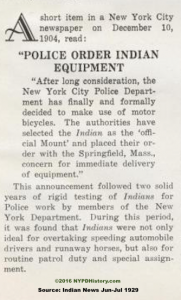
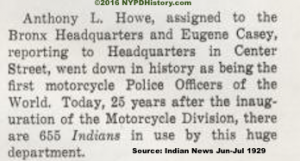
According to NY City records, in June of 1905, the city purchased two motorcycles from the Hendee Manufacturing Company of Springfield, Massachusetts at a cost of $151.30 each. One motorcycle was designated for delivery to the Thirty-third Precinct (1854 Amsterdam Avenue, Manhattan) and the other to the Thirteenth Precinct (138 Delancey St., Manhattan).
This is the earliest record found for an expenditure for motorcycles purchased for use by the PDNY and it came during the tenure of Police Commissioner (PC) William McAdoo. According to the records of the PDNY, on June 7, 1905, Bicycle Roundsman Eugene Casey and Bicycle Patrolman Benjamin Mallam, both of the Third Precinct (in City Hall), were temporarily assigned to the Central Office Squad, which operated out of police headquarters (called the “Central Office” in the period), located at 300 Mulberry St., Manhattan under the direction of the PC. Their presence in the City Hall Precinct would have put them together with the first Indian motorcycle(s).
PC McAdoo put Casey and Mallam to work quickly. The New York Times reported that on July 20, 1905 both men “mounted on motor cycles” arrested several drivers in the vicinity of Broadway and Fifty-seventh Street for using false registration numbers on their automobiles.

On October 15, 1905, the New York Herald carried a full page feature article entitled “The Need for An Automobile Police.” The article provides the the earliest photographs, found to date, of the 1905 single-cylinder Indian motorcycles used in the enforcement of vehicle and traffic laws involving automobiles! The caption of the photos, identifies the men as Roundsmen Casey and Ptlmn. Mallam.

By 1907, the PDNY had ordered additional Indian motorcycles from the Hendee company. The New York Times, in an article dated May 19, 1907, provides a description of the motorcycles used by Acting Sergeant Mallam and the PDNY. “The bicycle squad is supplied with twelve single-cylinder machines capable of going fifty-two miles an hour. Last week Commissioner Bingham held a test of a new double-cylinder motor cycle, run by Serge. Benjamin Mallam of the Central Office Squad.” According to NY City records, on May 28, 1907, the City approved PC Theodore A. Bingham’s request to purchase fifteen motorcycles at a cost not to exceed $3,000.
Additional information about the purchase of these 1907 Indian motorcycles was found in a book entitled “You Know You’re In Massachusetts When,” published in 2006 by authors Harris & Lyon. In discussing the history of the Hendee Manufacturing Company’s Indian brand motorcycles, it was written that in 1907, the PDNY “purchased a pair of the new Twins. The officers praised the left-hand throttle that let them give chase and draw their sidearms at the same time.” The identification of the model will likely be of particular interest to motorcycle enthusiasts.
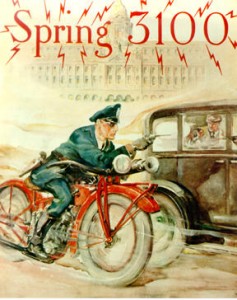
According to the records of the PDNY, on June 7, 1907, Roundsman Eugene Casey was transferred from the Twenty-seventh Precinct (Central Park Arsenal) to the Central Office Squad. Likewise, by way of the same Order, Ptlm. Benjamin Mallam of the Thirteenth Precinct (Delancey Street) was transferred to the Manhattan Central Office Squad.
The Annual Report of the PDNY for 1907 (for activity in 1907) details that there were expenditures of $1,053 for “New motor cycles,” $176 for “New bicycles,” and $2,836 for “Motor cycle and bicycle repairs.” The Annual Report of the PDNY for 1908 disclosed that on November 22, 1907, the department was authorized to purchase the fifteen motorcycles. The report indicated that “two 5-horsepower twin-cylinder motor-cycles and thirteen 3 1/2-horsepower single-cylinder machines had been ordered, and same will be delivered in the early part of 1908.”
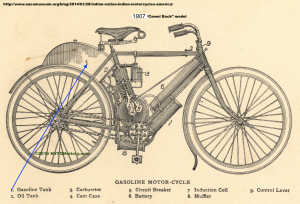
In 1916, The U.S. Census Bureau reported that the number of motorcycles in use by the PDNY in 1907 was twenty and increased to 115 by 1915. According to the Annual Report for 1907, “on account of the number of automobiles speeding” the number of men assigned to the “Bicycle Traffic Squad” had been increased. The accompanying illustration, from the website cited in the image, depicts the 1907 model Indian called a “Camel Back” because of “hump” shaped gasoline tank over the rear wheel. In one of the above four photographs from the Herald’s article, the “hump” can be seen as it can in this photograph of a PDNY officer, taken from a November 1940 article on the history of Indians in the PDNY.
Roundsman Casey and Ptl. Mallam mounted their “wheels” and were out to make headlines and history. This was largely due to PC Bingham’s solid support for motorcycles, his enthusiasm for racing, and his affection for his “Ace” motorcyclist, Benjamin Mallam. The department went “full speed ahead” with their motorcycles. The newspapers of the period often covered races between bicyclists, motorcyclists, automobilists and various combinations thereof. In the case of the PDNY, these races were a way to show off the talents and skill of their officers. For example, Bicycle Squad Roundsman John Scheussler, who we met in the previous release of “The Deal,” was a nationally recognized bicycle racing champion. Regarding competition between Mallam and Casey in the motorcycle races, which were held at raceways, like Morris Park (Bronx) and Empire City (Yonkers), it was Mallam who grabbed the notoriety, titles and headlines.
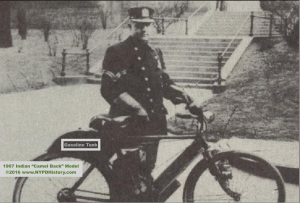
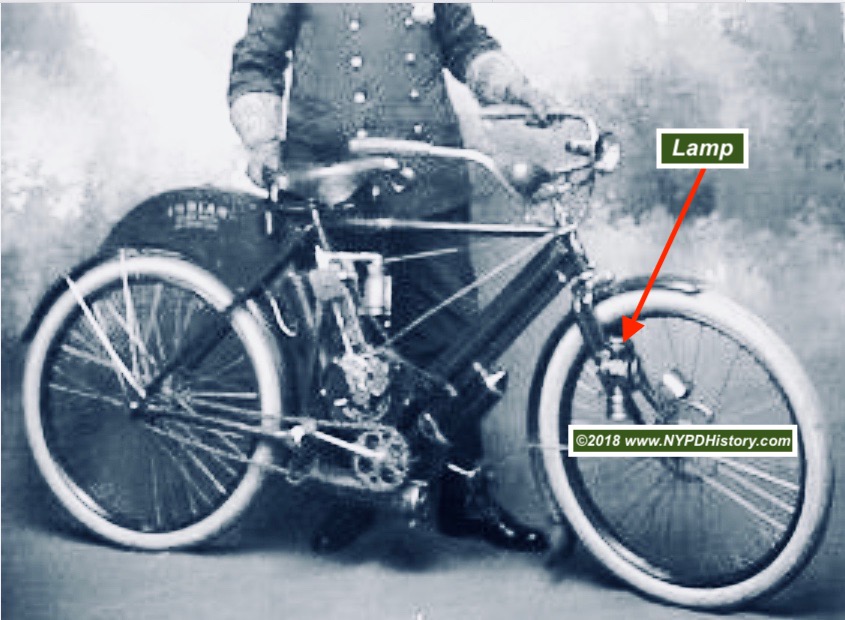
In an article published in the New York Herald on October 20, 1907, headlined “Mallan Wins Six Police Cycle Races,” (sic) we learn that Sgt. “Mallam carried off first honors at the third annual races of the Motor Cycle Squad of the (PDNY) held at the Empire City Track.” The article mentions the relationship between Mallam and PC Bingham relating “Mallan (sic) who is a favorite of Commissioner Bingham rode in each race with a daredevil recklessness that thrilled the spectators in the stand. Hugging the rail closely, the nervy policeman would pass his competitors with a hairbreadth closeness that was nerve shocking.” Demonstrating PC Bingham’s interest, the article describes how Bingham, acting as “Referee’, “hustled the men along in each race, permitting no laxity to prevail.” Officer Casey participated in the races as well, but never surpassed Mallam’s records.
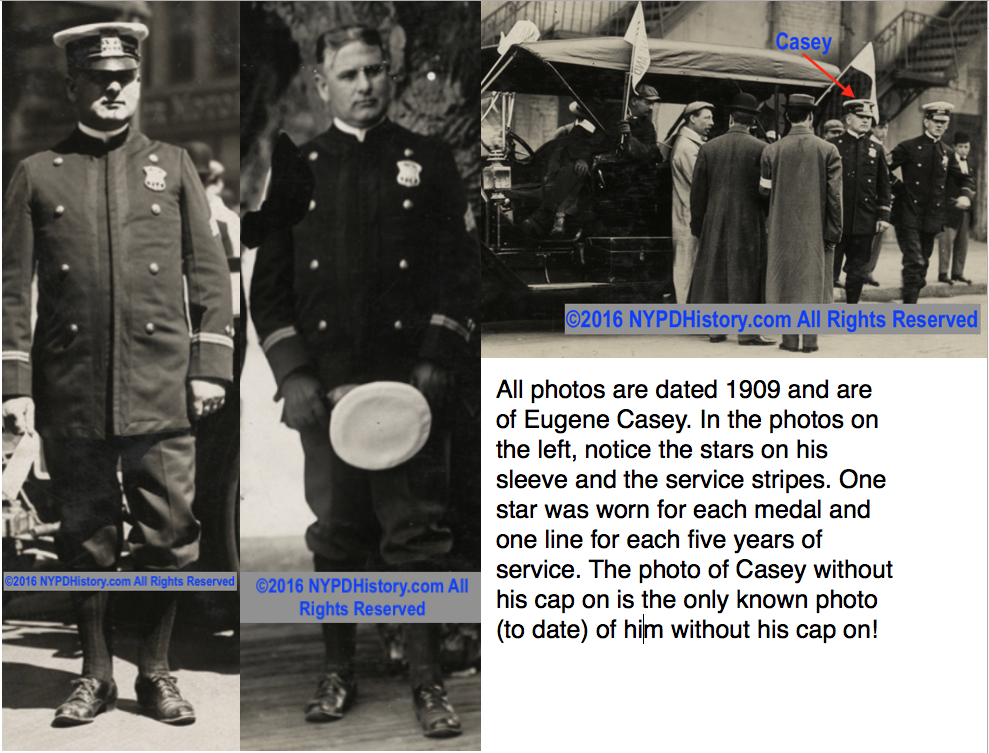
Adapting to the need to determine the speed of automobiles and to catch more powerful automobiles, we learn from an article published in the New York Herald on January 25, 1908, which describes the use of a “Wigwag System” of speed detection. This modification of the present police booth system was employed by Officer Casey of the Motorcycle Squad in order to catch a speeding auto which held a world’s record for speed. Apparently, the automobiles owned by the PDNY were not capable of catching a sixty horsepower auto, which held a record of averaging seventy miles per hour over a twenty-four hour period on a London track, that was the target of Casey’s enforcement.
Set-up two blocks apart in midtown, Manhattan, and anticipating the car’s route, Officer Frank Rickert waved a handkerchief when the auto passed him. Officer Casey timed the duration of travel and calculated the rate of speed at twenty-five miles per hour. “To catch the big car the policemen had to press into service the 60-horse power Panhard of A.S. White of 104 East Thirty-eighth street, Manhattan. The driver, Lucian R. Burne was arrested.
The New York Press, on May 16, 1909, published an article which related that Sergeant Mallam, “who is reputed to be the fastest of General Bingham’s flying squad” and “the pride of the motor cycle squad of the (PDNY) demonstrated to the satisfaction of his superiors and the large crowd of enthusiastic guests that he well deserved the title by capping the premier laurels at the annual motor cycle races of the department held yesterday morning at the old Morris racetrack in Westchester.” (Bronx) The article indicated that Mallam injured his leg when he hit a rock, but he was able to continue the race.
It should be noted that all of the officers and squads discussed in the series to this point were not alone. Several articles published in 1906, 1907, 1908 were found which identified members of a “Brooklyn motorcycle squad,” “Brooklyn Headquarters Squad,” and other variations who were active in enforcing vehicle and traffic laws. In fact, in 1909, according to an article published on March 1 of that year in Motorcycle Illustrated, we learn that it was Inspector Maximillian F. Schmittberger who earlier had “introduced the idea of assigning the men in Brooklyn to posts” (perform patrol duties); that “On account of the wide stretches of territory to cover, the men over there (Brooklyn), up to about four weeks ago, had considerable latitude” and were sometimes not in contact with supervisors for hours. The article continues, relating that Chief Inspector Moses W. Cortright (today’s rank of Chief of Department, the highest uniformed rank) issued an order that motorcycle officers must telephone their commands hourly giving their location and number of telephone.” This did not resonate well with the officers who complained that they often worked eighteen to twenty hours per day and described the order as “a case of hold your nose to the grindstone all the time.”
The decision to assign Brooklyn-based motorcycle officers to additional duties to patrol was rescinded in early April 1909 by PC Bingham who restored the officers to their former duties of concentrating on the enforcement of vehicle and traffic laws in order to reduce traffic crashes. The article, published in Motorcycle Illustrated on April 15, 1909 ended with a sentence that “Scores of other cities have followed or are about to follow the example of the (PDNY), so that the little two-wheeler is being made to serve an excellent purpose in practically every city of any consequence throughout the country.”
An article appearing on April 24, 1934, in the New York Sun, recaps the history of the use of motorcycles by the PDNY. The retrospective credits Sergeants Casey and Howe (followed by John Nerney) with being the first to lead motorcycle squads. Of historical significance is the following statement which adds credence to the position of some historians that the first dedicated Motorcycle Squad was not formed until after 1910: “They (the squads) had dual assignments on account of their rank. In conjunction with looking after traffic violators they also supervised patrol in the outlying districts of Manhattan and the Bronx.” Additionally, Mallam and Casey performed the duties assigned by the PC of investigating suspected violations of departmental rules, and criminal laws committed by members of the police force. While performing such duties, the Roundsmen were referred to as the “Shoo Fly Squad” by the men of the force, and others.
Several sources, including Annual Reports of the PDNY, newspaper articles, and various PDNY and NY City records reflect the fact that the “Motorcycle Squad” was the result of the Bicycle Squad’s inability to deal with violators driving the faster automobiles and motorcycles. It would not be until 1911 that a dedicated Motorcycle Squad, attached to the Traffic Squad, would be established under PC Waldo Rhinelander.
“What’s The Deal With:” The early enforcement of automobile traffic laws by the PDNY motorcycle officers? In 1903 and 1904, the PDNY tested motor-bicycles manufactured by the Hendee manufacturing Company, and in 1905, purchased two single-cylinder “wheels” used by officers Casey and Howe, and others. The motorcycles were effective in enforcement of the law that in 1907, an additional fifteen Indian Twin V-2 cylinder “Camel back” “wheels” were ordered. PC Bingham, officers Anthony Howe, James Nerney, Benjamin Mallam, Eugene Casey, and others can be credited as being instrumental, pioneers in the early adoption, adaptation, promotion, and expansion of the use of motorcycles by the PDNY. The officers of today’s Highway Unit owe much to these men and their memories should be memorialized in some appropriate way by the PDNY.
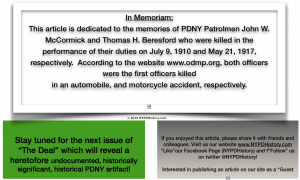
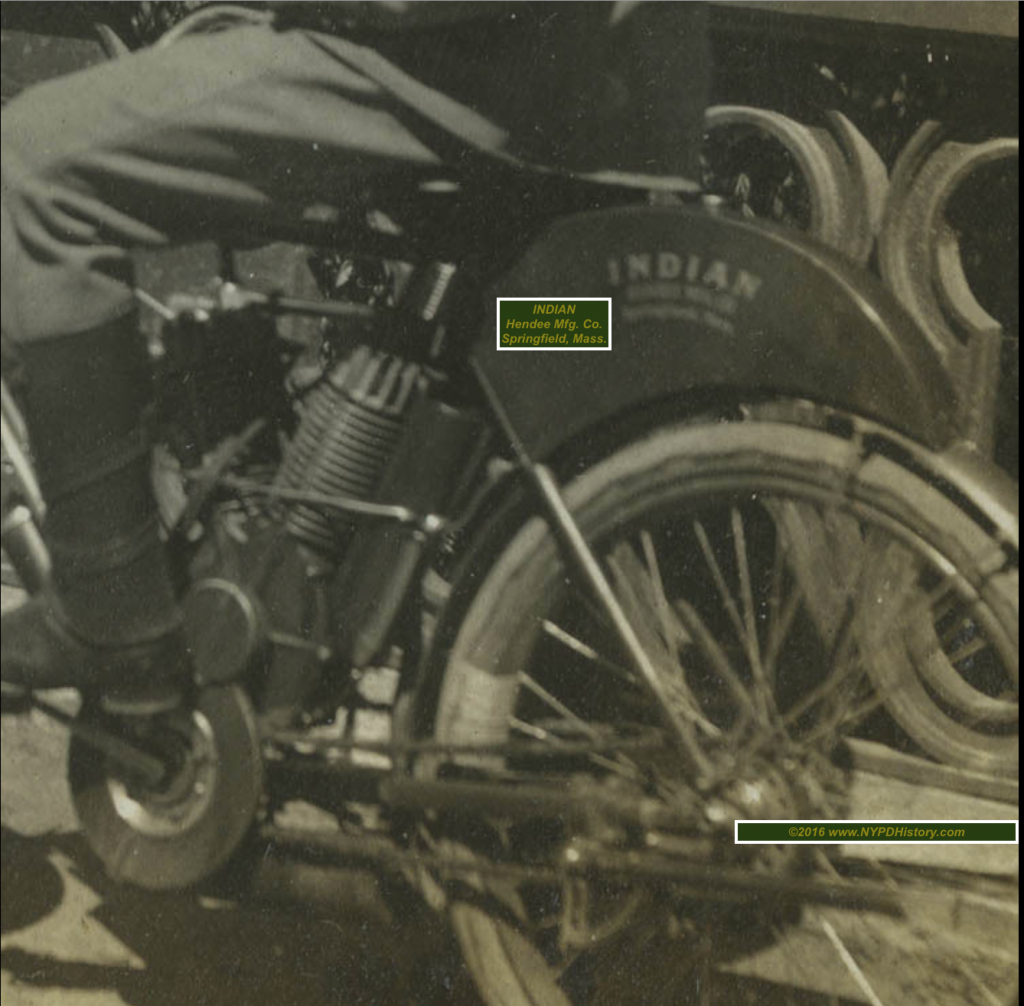
![]()

Leave a Reply
You must be logged in to post a comment.